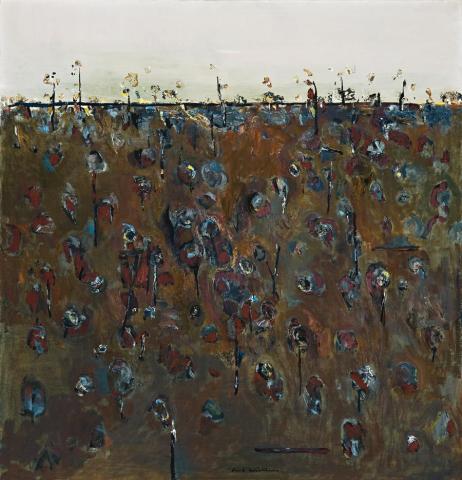EVENING SKY, UPWEY, 1965
Fred Williams
oil on canvas
135.0 x 130.0 cm
signed lower centre: Fred Williams
studio label attached verso with title, date and number LW1139
Acquired directly from the artist, Melbourne, late 1960s
Private collection, Melbourne
Among the several masterpieces in the Upwey series that Fred Williams painted in the mid-sixties, Evening Sky, Upwey is one of the best. Of these, Upwey Landscape I was formerly in the BP Collection, London, and II and V are in the collections of the National Gallery of Australia, Canberra, and the Art Gallery of Ballarat. Another, Landscape in Upwey II won the 1967 Georges Invitation Art Prize and Upwey Landscape V was awarded the 1966 Wynne Prize. If that were not enough, Upwey Landscape 1964-65 is in the Tate Gallery, London, and two further great paintings, Upwey Landscape III is in the National Gallery of Victoria, Melbourne, and IV in the Newcastle Region Art Gallery. When most of these works had their public debut at Rudy Komon's Sydney gallery in October 1966, they were received with critical acclaim. Wallace Thornton, art critic of The Sydney Morning Herald referred to Williams as 'a magnificent painter', and proposed that there was 'every chance he will go down in history as Australia's greatest landscape artist.'1 James Gleeson praised him as one of those 'rare landscapists who, like Drysdale and Nolan, have so imposed their personal visions upon a generation that we tend to see reality through their eyes.'2 The exhibition sold out; and when Williams' show opened at Georges Gallery, Melbourne the following year, the borrowed paintings carried the names of distinguished collectors of the likes of Rupert Murdoch and Mrs and Mrs Gordon Darling.
Evening Sky, Upwey, which has long been in a private collection, is now on the market for the first time and can enjoy the public acclaim it rightly deserves. A work of great exuberance, an engaging animation flows through the lively technique, richness of texture, and sumptuous colour. Conceived in classic Williams' format of a high horizon and broad expanse of land rising vertically rather retiring into the picture, the emphasis on the picture plane allowed the artist a range of opportunities in the inventive play between surface and illusion. One of the most attractive features of this and other master paintings in the series is his handling of paint " spontaneous gestures set in fields of carefully considered composition. Textured touches of the colour-laden brush and painterly whirls define foliage, scrub and trees, contrasted in relief against the fluid gestures of thinly applied backgrounds of velvety browns. The scrubbiness of the scene is ordered and balanced by the perfect placements of the verticals and horizontals, mainly as images of tree trunks. Mindful of traditions in art, James Mollison has pointed out that, in Upwey Landscape III Williams paid 'tribute to the works by Gustave Courbet (1819-1877) that he had recently seen in Europe. He had always been attracted to the thick, impenetrable pastes of Courbet's rocks and foliage, and to the density of his green and brown paint, and he admired the modernity of the French's artist's landscapes.'3 It was also a time when Williams began experimenting with night scenes, Evening Sky, Upwey being one of many steps taken towards paintings such as Green Cloud and Owl, 1967, (National Gallery of Australia, Canberra) and the use of a predominance of Prussian blue to capture the night effects. The Upwey series has reserved itself an honoured place in the history of Australian landscape painting.
1. Thornton, W.,'Is this our greatest landscape painter?' Sydney Morning Herald, 12 October 1966, p. 22
2. Gleeson, J., 'Williams Is At His Best, Sun, Sydney, 12 October 1966
3. Mollison, J., A Singular Vision: The Art of Fred Williams, Australian National Gallery, Canberra, 1989, pp. 89-90
DAVID THOMAS
